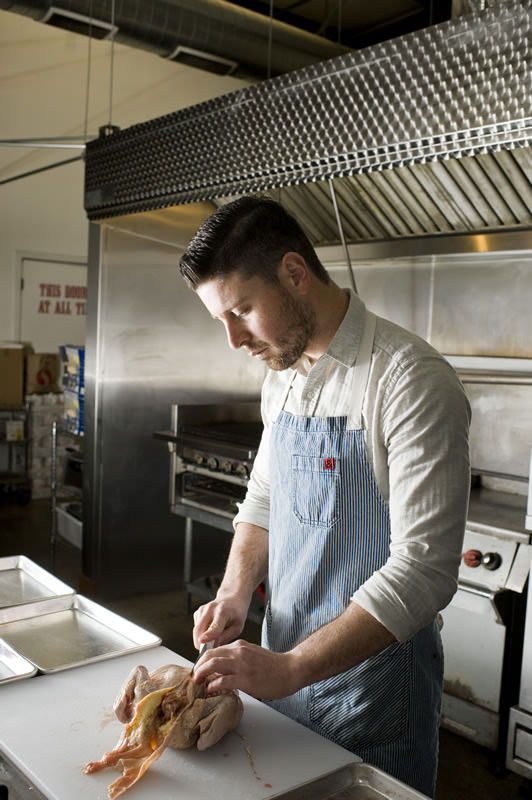tips & tricks
CHICKEN BUTCHERING
Learn how to cut up the whole bird, and what to do with it afterward.
WRITTEN BY JENNIFER RACHEL BAUMER
PHOTOS BY CANDICE NYANDO
Tastes, textures, timing, finances, and philosophy — there are a number of reasons to choose a whole chicken as the basis of several meals. But if you’ve ever found yourself intimidated by the thought of cutting a whole chicken into pieces, you’re not alone.
“A whole chicken is more economical,” says Josh Deri, chef/co-owner of Blend, a catering company in Sparks, along with his wife, Whitney. “And you know where it’s coming from.”
When you have a whole chicken, he explains, you’re not getting pieces from different sources. Blend’s chickens come from two sources: Reno’s own Butcher Boy Meat Market and Mary’s Free Range Chickens from Sanger, Calif. Deri says the chickens from Mary’s are air chilled, making for a great, crispy skin.
A whole chicken can be roasted, fried, or even poached to allow for crispy skin on the outside and juicy meat on the inside. Breaking the chicken down allows individual pieces to cook at the temperatures they need — cooking a whole trussed chicken is apt to leave soft or soggy meat and skin under the folds.
Plus, using every part of a whole chicken just makes good economic sense — buying a whole chicken usually costs less than buying the pieces separately — and it helps prevent the waste of unused parts.
The preparation of one of Deri’s favorite recipes, chicken galantine (recipe provided[JS1] ), starts by using the whole, unbroken skin. Every piece of the chicken is used in preparation of the dish, from wing tips in the stock to the skin that wraps around the light and dark meats.
Step-by-step guide
Start by removing the skin. Use the tip of a knife to make the first cut over the back, then gently scrape the skin from the meat, laying it out as you go. Scrape the fat from the skin. (The fat can be rendered down later in a saucepan and strained to use in place of clarified butter or canola oil in other recipes.)
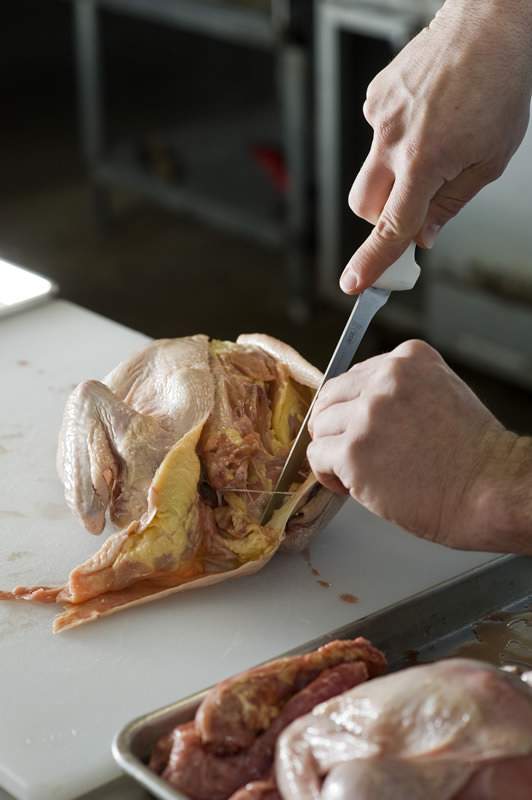
To break down a chicken, Deri follows the natural seams all animals’ bodies have. He begins by breaking bones that hold the legs and wings to the body; that makes it easier to see what you have to work with.
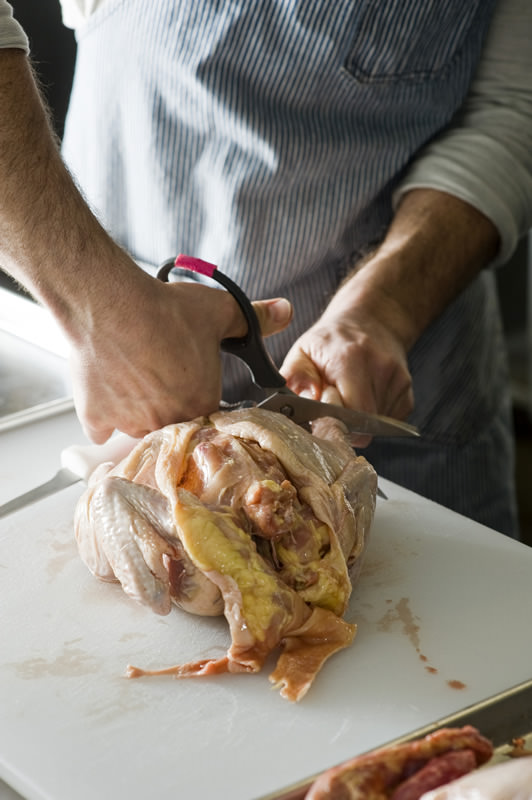
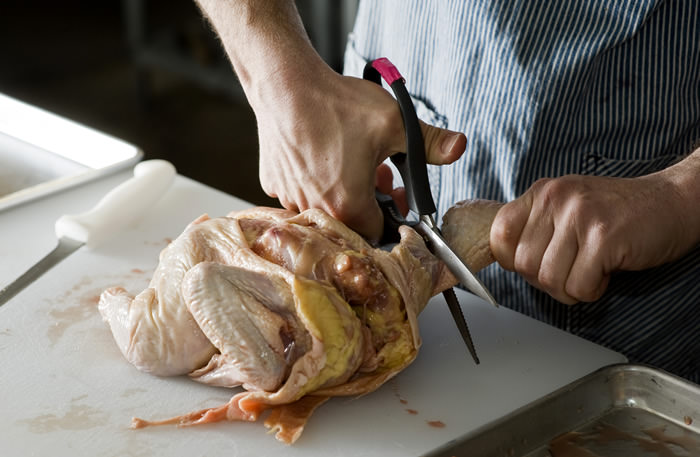
Next, separate the chicken into individual parts. Start with the legs, then remove the wings, which have already been broken free of the body, making it easier to cut through connecting bone with a sharp knife or kitchen shears.
“I don’t like cooking the wing and breast together, if you’re searing the breast piece or frying it, because they cook at different times,” Deri says. “I like to break it all down for the different cooking times.”

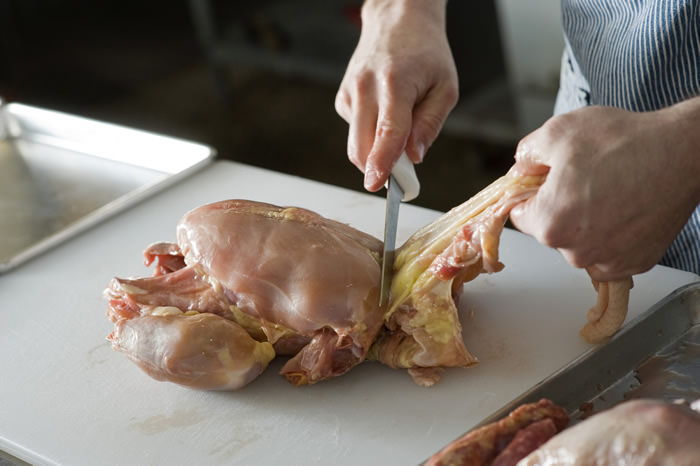
Turn the chicken over, breast-side down, and make a cut along the back, from head to tail. Make the cut with the tip of the knife; cutting with the whole knife risks cutting too deeply and losing a lot of the meat on the bones. Mistakes can be corrected if you start with the tip of the knife because you’re not cutting in too deeply. Remove the meat that’s attached to the spine and all along the ribs, then chop the bones that hold the wings and legs to the body.
Separate the chicken into sections (you’ll need to separate the light and dark meat for the galantine recipe that follows). Once the meat is cut from the bones, chop the bones into small pieces for chicken stock, rather than using the whole carcass. The more surface area of bone in your stock, the better the flavor, Deri says. Leave the breast meat on the carcass until last so it’s easier to work with.
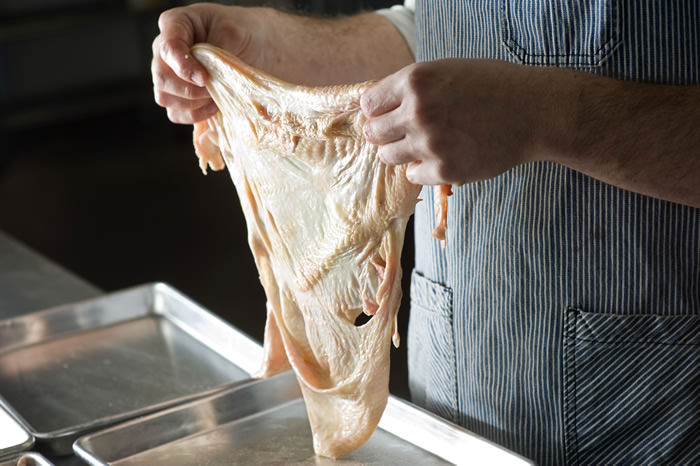
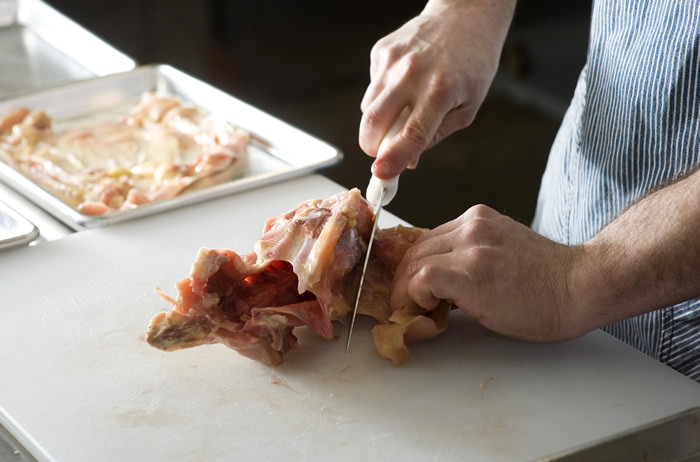
The key is not to waste anything. So once the drumsticks are removed, trim the bottoms, then remove the wings, which easily can overcook or burn. Instead of wasting these parts, add them to the stock with the bones.
If there’s leftover skin, crisp it in the microwave or oven and use it to make hors d’oeuvres. Deri has used the skin with steak tartare and with scallops.
“Don’t just throw it away. Definitely save the fat and render it down for cooking,” Deri says. “Using the whole chicken is definitely the best. You get your stock, you get your fat for cooking, you get a lot of different pieces you can do different things with, frying or roasting whole or the galantine or serving crispy chicken legs. It’s the best way to do it. Buy it whole and go from there.”
Known to whimper in the face of chopping up a whole chicken, Reno-based freelance writer Jennifer Rachel Baumer feels somewhat more confident now. Summertime fried chicken will be her proving ground.
Resources
Blend
615 Spice Island Drive, Ste. 4, Sparks • 775-843-5297 • Blendcateringreno.com or Info@blendcateringreno.com
Recipes
Chicken Galantine
(courtesy of Josh Deri, co-owner, Blend in Sparks. Serves 3 to 4)
1 whole chicken
2 garlic cloves, minced
1 teaspoon lemon thyme, minced
½ Meyer lemon, zested
1 teaspoon Aleppo chile, dried and crushed
½ teaspoon toasted ground cumin
Salt, to taste
With kitchen scissors, remove wings and bottom of legs first, to more easily remove skin in one piece and reserve pieces for chicken stock.
Next, remove skin in one piece, working from back of chicken first, using tip of sharp boning knife.
Lay out skin on dry cutting board, and with knife, remove excess fat using scraping motion. This ensures less greasy chicken and crispier skin.
Remove legs, thighs, and breasts from chicken carcass. Slice breasts in half lengthwise and reserve.
With boning knife, follow natural seams of chicken legs and thighs, and remove as much meat as possible from bones. Combine with all aromatics and spices (you’ll want a little of the fat in this mix as well).
Pull dark meat, spices, and aromatics through meat grinder, or chop them finely with a heavy knife to achieve a similar texture.
To assemble galantine:
Lay out skin on dry cutting board in shape of rectangle. Season with salt. Spread mixture of dark meat and spices in even layer on skin, starting from bottom of rectangle. Add enough to create an even layer running three-quarters of the way up skin. Season with salt. Add reserved breasts and lay evenly on top of dark meat, leaving some room so you can see the dark meat mix on top and bottom of breasts.
Next, begin to roll cylinder to create galantine. Work from bottom to top, like rolling a burrito, tucking ends in after a couple rolls. Once tightly rolled, use butcher twine to tie off galantine in at least 5 even places; this will ensure it stays together during cooking.
In wide, short-sided pot filled with flavorful cooking liquid (water or stock) and aromatics such as sliced garlic, sliced onions, sliced lemons, or salt and pepper, bring cooking liquid to 215 degrees F. Then add galantine to liquid and cook until a kitchen thermometer inserted into tied galantine reads an internal temperature of 155 degrees F, about 25 to 35 minutes (check about every 15 minutes).
Using small fryer or pot filled with rendered chicken fat or grapeseed oil, set oil temperature to 365 degrees F. Once temperature is reached, begin frying galantine to crisp skin. While frying, move galantine around so that entire skin becomes crispy. Once skin is golden brown and of desired crispness, remove from fryer and season with salt and light squeeze of fresh Meyer lemon juice.
Serve with your favorite vegetables. Deri suggests morel mushrooms, fresh peas, fava beans, baby radishes, green garlic, or the Deris’ favorite: foraged wild Sierra onions and asparagus. Prepare and cut all vegetables and cook simply, with some butter and chicken stock. Add a little salt, fresh Meyer lemon juice, and freshly cracked black pepper.
Chicken Stock
(courtesy of Josh Deri, chef/co-owner, Blend in Sparks. Makes 4 to 5 cups)
1 chicken carcass, along with wings, wing tips, and cut-off pieces of legs
1 onion, thinly sliced
4 garlic cloves, thinly sliced
Preheat oven to 450 degrees F. Spread chicken carcass and reserved pieces of legs and wing tips on pan. All pieces should be cut into small pieces about 2-by-2-inches to ensure maximum surface area, resulting in more flavorful stock. Roast until bones are golden brown; remove from oven.
Fill large, high-sided pot with water, about 6 to 8 cups. Add roasted bones, wings, and wing tips to pot of water and bring to light simmer. Simmer stock for at least 8 hours to extract the most flavor and gelatin out of roasted bones. In last hour of cooking, add onion and garlic.
When finished, taste stock to ensure it’s flavorful, then strain out bones and reserve some stock to cook spring vegetables in, as a side dish.
